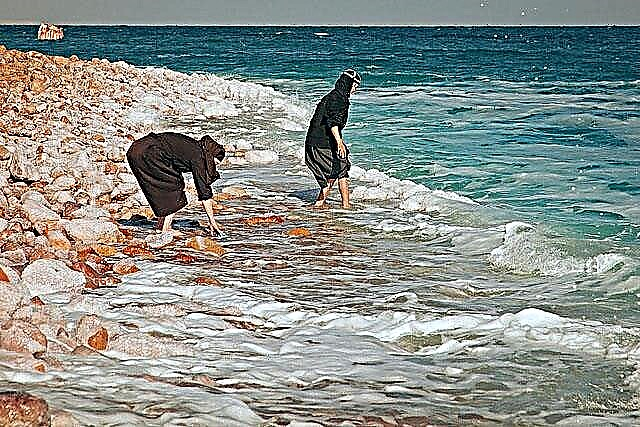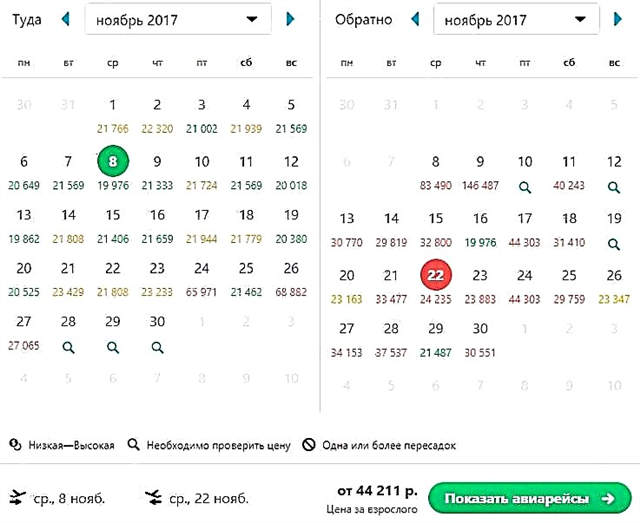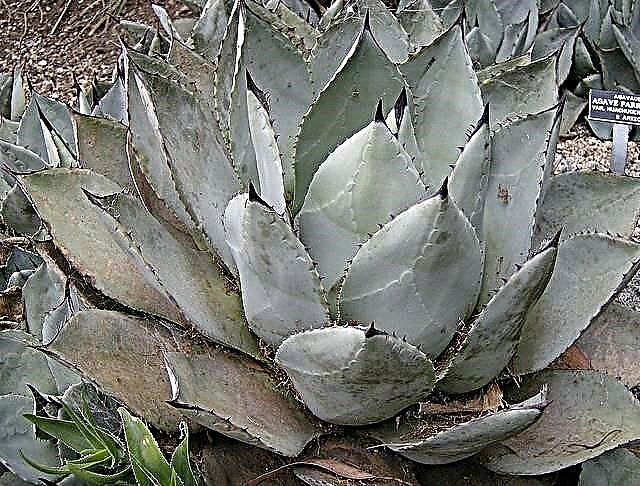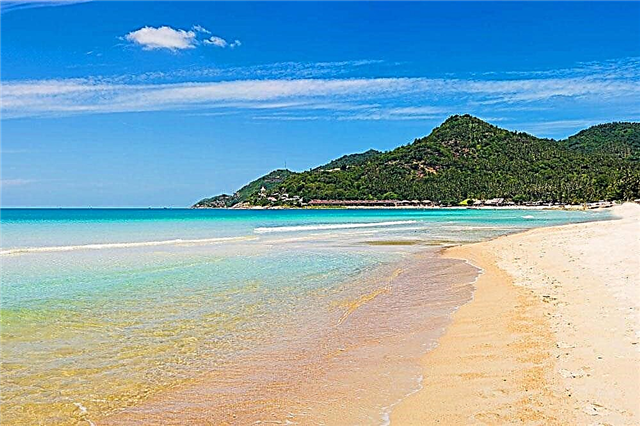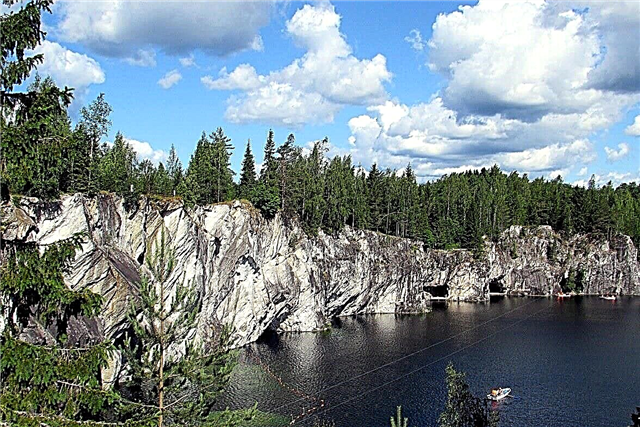A magical lake land with an ancient history is striking in its untouchedness. Existing alongside modern technologies, the nature of Karelia remains pristine - as if no man's foot has yet set foot here. People come here from noisy, stuffy cities to breathe in the freshness of coniferous forests, to get enough of the aroma of medicinal herbs. And Karelia generously endows its guests with the healing power of the earth.
The glassy expanse of reservoirs, mineral springs and swamps form fantastic locations for recreation. The expanses of the republic will give vivid impressions to hunters and fishermen, and those who like to capture on film will take their breath away from local natural monuments.
The most interesting natural monuments of Karelia
List, photos with names and descriptions of places worth visiting!
Marble quarries in Ruskeala village
In the middle of the 18th century, marble deposits were developed in the area of Lake Ladoga. As a result of human intervention in the natural landscape, adits and quarries became, over time, filled with water. The unusual place was turned into a Mountain Park, ennobled and created a real tourist town. Climbers, divers and couples who prefer calm boating come here.

Cape Kintsiniemi
Near the village of Soanlahti there is one of the most studied geological objects - Cape Kintsiniemi. From the side of the Soanyoki River and on the cliffs of the dolomite quarry, one can observe the outcropping of mountain strata, which are more than 2 billion years old. To preserve the unique natural monument, the territory of the cape is protected. But for those wishing to plunge into the era of antiquity, excursions are held.

Vottovaara mountain complex
A mystical place with strong energy 20 km from the village of Sukkozero beckons those who are not afraid to face the inexplicable. Crooked trees on the slopes, stone slabs of clearly unnatural origin give rise to legends around the mountain. Karelians are afraid to come here unnecessarily, and curious tourists, esotericists and ufologists are frequent guests here. It is believed that in the old days the Vottovaara peak was used for sacrifices.

Waterfall White Bridges
The Finns called the waterfall Yukankoski, and the romantic name White Bridges appeared already in the 20th century. Once upon a time there really were bridges of white stone, now in their place are ruins. The waterfall itself is rather big - 18 meters. From the village of Leppäsilta to this place is only 13 km. But forest thickets create the impression that hundreds of kilometers around are impenetrable forests. On the glades next to the waterfall, you can put up a tent and enjoy the sound of the water.

Don't Miss: 20 Best Waterfalls in Karelia
Girvas section of the Suna river canyon
The village of Girvas was created by workers during the construction of the dam, but this is not at all famous. On its territory there is the oldest attraction of Karelia - the volcano crater. It is about 2 billion years old, and layers of solidified lava can be observed in the bed of the drained Suna River. The geologists who study them can tell a lot about the past of these places, so an excursion to Girvas will undoubtedly bring pleasure.

Urozero
A small reservoir 25 km from Petrozavodsk attracts vacationers with crystal water and is considered the cleanest lake in Karelia. Urozero is located on the territory of the reserve, and lovers of comfortable rest can stay at the tourist centers. The transparency of the water here is so high that the bottom is visible even at a depth of 10 meters. And almost no algae is observed. The lake is rich in fish, especially pike and burbot.

Murray Pines
In the village of Impilahti there is a plantation of Murray pines. The natural monument is interesting because the Murray pines were bred in North America, and the climate of Karelia is alien to them. But in the 30s, the seedlings successfully took root, and now the natural monument of the Pine of Murray reminds of the achievements of domestic botanists. There are only 18 trees - and this is the first planting of this species on the territory of Russia.

Vazhinskoe swamp
One of the largest swamps in Karelia, 100 km from Petrozavodsk, has a depth of more than 5 meters and a size of more than 150 km². This is a classic swamp with islets, swamps and lakes formed after the melting of glaciers. Wading birds nest here, and cranberries and cloudberries grow in huge numbers. Fishing and hunting allowed. Part of the swamp belongs to the Vazhozersky reserve, which belongs to the monastery.

Mount Nuorunen
The highest mountain in the region is located in the Paanajärvi Park. It is not difficult to get to the top - only 21 km along relatively easy paths for climbing. Of the sights along the way, you will meet the old border with Finland, a couple of pretty mountain lakes and Sami shamanic monuments. The Finnish mountain Ruka is even visible from the top. Visitors to the national park must register before hiking.

Damn chair
This natural monument really resembles a chair in shape, although it is just a bizarrely frozen lava of the former volcano Bolshaya Vaara. Residents of Petrozavodsk love to relax in the vicinity of the Devil's chair, and for tourists it is of particular interest. There is an opinion that the chair grants wishes. But its main feature is that the rarest plants listed in the Red Book live here.

Lake Paanajärvi
In the middle of the coniferous forests lies a lake, which is not inferior in beauty to Lake Baikal. The depth of Lake Paanajärvi reaches 120 meters, and there are plenty of fish here. But you need to get a permit for fishing - after all, the lake is considered part of the reserve. In windy weather, huge waves rise on Paanajärvi. But on a sunny day, you can rent a boat here and explore the surroundings - the ruins of old Finnish settlements and picturesque cliffs.

Uksinskaya ozovaya ridge
10 km from Pitkyaranta there is a network of amazing lakes, the bottom and shores of which are dotted with huge stones. As a reminder of glaciers, they have been here for over 10 thousand years. The absence of silt makes the bottom of the lakes incredibly transparent. For those who prefer solitude, the Uksinskaya ridge is ideal - there are a lot of small islands in the lakes. In the vicinity of the ridge there are several tourist points where you can stop for a halt.

Klim-gora
The Klim Peninsula in the Medvezhyegorsk District is good for families. More than two kilometers of sandy beaches, coniferous forests and absolute unity with nature await those who visit the foot of the Klim Mountain. The height of the mountain is only 86 meters, but in terms of beauty it is incomparable with its larger counterparts. Those who are going to hunt or fish here in Lake Onega need to obtain a special permit.

Kumi threshold
The famous waterfall is not known for its height - only 15 meters. But he does not lack power - even in severe frosts, the Kumi threshold does not freeze. From the village Voynitsa to the miracle of nature 25 km. It is not difficult to find a waterfall in the forest thicket - the stream can be heard from afar. Nearby there is a good place for parking, it is difficult to meet someone here, the rest will be calm and secluded. The Kumi threshold is located near the Finnish border, so travelers will need documents.

South Deer Island
In the north-west of Lake Onega, there is a tiny island with an area of about 75 hectares, which bears the name of South Deer. It is extremely interesting for archaeologists - burials of ancient settlers were discovered here at the beginning of the 20th century. The finds date back to the late Mesolithic period and are of great historical value. From the point of view of geology, the island is also significant - the local rocks are more than 2 billion years old.

Spring "Three Ivana"
The healing spring "Three Ivans" is a place of pilgrimage for believers. People come here in the hope of curing skin diseases and problems of the gastrointestinal tract. The composition of the water really has medicinal qualities.The high content of calcium and magnesium rightfully makes the source miraculous. You can get here by driving 6 km from the village of Cherkasy, Medvezhyegorsk District. The protected area around is guarded, but the entrance to the spring is free.

Shungsky section
Near the village of Shunga there is a unique sight - deposits of shungite or petrified oil. The value of the object is that nowhere on the planet is shungite located so close to the earth's surface. The extraction of rare rocks is prohibited here, but there are still cases of illegal development of the deposit. The mines are closely guarded, and unauthorized visits to the Shungskoye mine are prohibited.

Spring "Salt pit"
Near the village of Velikaya Guba there is a little-known place - a drinking spring with salt water. Its history is shrouded in secrets, but mentions of the healing spring date back to the 18th century. The water here has a pronounced smell of hydrogen sulfide, and the source itself is a small hole in the middle of a swampy area. Locals willingly use spring water as drinking water and for the treatment of all kinds of ailments.

Lake Vargachnoe-Korbozerskoe
This natural monument in the Vodlinsky forestry became protected only recently, namely in 2016. In the protected area there are unique taiga forests untouched by human activity. There are critically few such forests in Karelia, so it was decided to create a landscape park. On 10 km² you can find rare plants, and the pride of local residents - a swan flock - lives on the lake itself.

Swamp by Lake Lelikozero
200 hectares of land, just 4 km from the village of Lambasruchey, occupies a swamp near Lake Lelikozero. And it is famous not only for its abundant harvests of cranberries and cloudberries. People come here to be treated with healing mud and collect medicinal plants. Hunting is allowed here only in a certain season, but picking berries and plants is available to everyone at any time.

Chelmuzhskaya spit
About 14 thousand years ago, a 13-kilometer spit was formed, dividing Lake Onega in two. Scientists to this day argue about what caused its occurrence, and are inclined to the consequences of the melting of the glacier. And tourists just enjoy the exotic scenery and fantastic fishing. In these places, burbot, pike perch and smaller fish are not transferred.

Sulazhgorsky spring
A popular place among residents of Petrozavodsk is a clean spring on the outskirts of the city. Local people collect water here for personal use. According to official research, the water from the Sulazhgorsk spring is drinkable, odorless and free of sediment. You can find the source in the north-west of Petrozavodsk, not far from the territory of the ski stadium.

Swamp Yuzhno-Gabozerskoe
The priceless natural monument of South Karelia, the Sandalskoye or South Gabozerskoye swamp, stretches over 357 hectares on the lands of the Kondopoga region. The alternation of endangered plants, sphagnum mosses and pine groves invariably impress those who are here for the first time. Swampy lake areas, transforming into dangerous swamps, are full of berries. But you can collect them only at a certain time.

Chimil glade
The area overgrown with pine needles near the Olonka River is used by the inhabitants of Olonetsk for outings into nature. And few people know the geological value of the Chimilskaya glade - the ancient landscape of these places has been preserved here. The reserved glade is a classic example of the Olonets glacial plain. The territory is popular among locals and visitors for the abundance of berries, mushrooms and, of course, for the bright Karelian landscapes.

Ropaki Swamp
In the Olonets reserve, 7 km from the village of Obzha, there is the first swamp in the republic, which was subject to reclamation at the beginning of the last century. Its size is almost 1000 hectares. Young deciduous and coniferous trees adorn the marsh expanses. But, if you look deeper, you can find sphagnum mosses and other representatives of marsh flora.


